 WWI Russian and civil war seaplane Carriers
WWI Russian and civil war seaplane Carriers
Interwar & WW2 Soviet Aircraft Carriers projects: 2 Conversions + Project 71, 72, 69A/B, 85
If Russia had to wait for decades (in fact the 1990s and Admiral kuznetsov), going full circle between Imperial, Soviet and Russian Federation eras, the country-continent was certainly not stranger to naval aviation, having one of the world’s most extensive coastline, nor the development of aircraft carriers, even though none really came to fruition before the hybrid Kiev class of the 1970s. The story started all the way back to 1912. At the time, the rapid development of naval aviation (in 1914 Russia was the world’s third air power) conducted the use of its first dedicated seaplane tenders… Many were converted and others operational in the civil war, followed by many projects in the interwar, including conversions, and project 71-72, if built, were on par with the best Western designs, there are subjected by the present article.
Origins: Naval Aviation of Imperial Russia
As World War I broke out, Russian Naval Aviation units were mobilized and played an important role in the Baltic Sea and Black Sea. But at the time, they were still at the stage of organizational formation. On August 1, 1914, the Naval Ministry had three dozen aircraft under his command, with 20 certified pilots to start operations. 10 more officers were trained and just 10 seaplanes were operational in the Baltic, based in Libau, 8 seaplanes in the Black Sea (Sevastopol, Kilen Bay). Detachments were planned for the Pacific Ocean in 1915, but that never came to fruition.
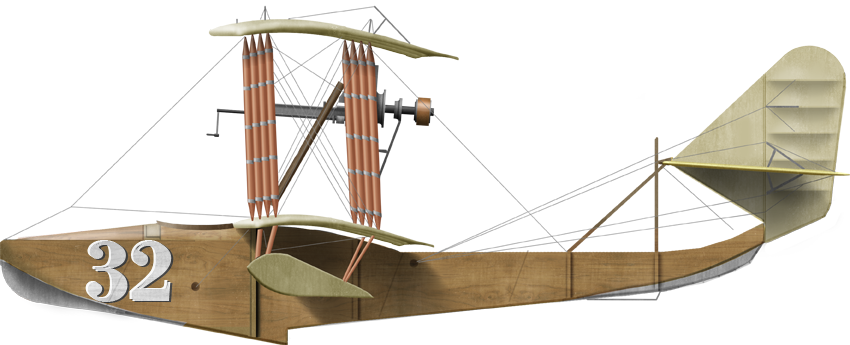
Grigorovitch M5 (1915)
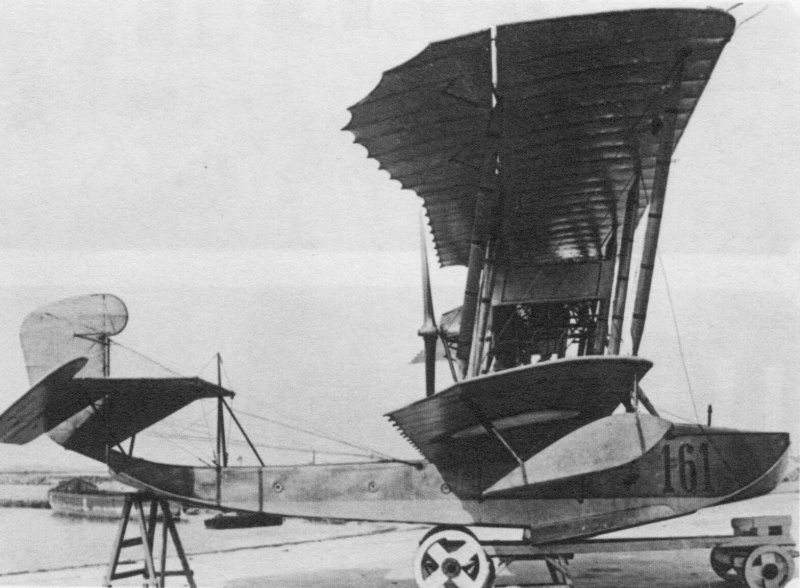
Grigorovitch M9 (1917)
By early March 1915, Russian Naval aviation was now 77 aircraft strong, with 47 in the Baltic, 30 in the Black Sea, most being Grigorovitch M5 seaplanes. This naval air staff comprised 78 officers and 859 lower ranks pilots, as well mechanics and administrative personal. Two support ships with six seaplanes operated in the black sea: One steamship was converted into a seaplane carrier, operating five Grigorovitch M-5 seaplanes. The cruiser Almaz was also rebuilt to operate seaplanes. The naval aviation section was part of the Black Sea Fleet and managed by the admiralty, like the Baltic.
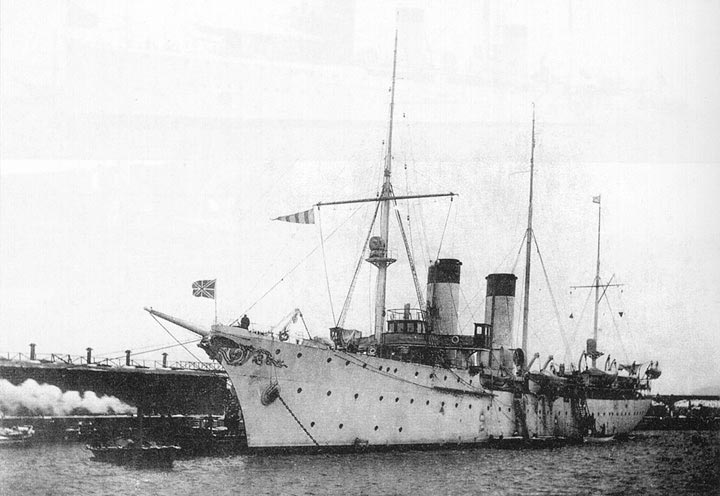
The cruiser Almaz
One key component of the Imperial Russian Naval Aviation was the capacity to project air power far from its bases, when using seaplane carriers. That category is often forgotten, but was in WWI as common as aircraft carriers in WW2. Russia never had time to built dedicated vessels (such as the British Ark Royal, Campania, Argus and Furious) but still managed to convert about eight vessels: Volodga, Orlitsa, and the Imperator Pavel class “aviation cruisers”: Regele Carol I and the two Romania class. They started operation for the latter in 1916. On 1 January 1917, Russian Naval Aviation had a total of 264 airplanes in service, including 152 land-based aircraft of all three types (fighter, reconnaissance, bomber), plus 4 small controlled balloons for the Black Sea Fleet. 88 aircraft were listed active in the Baltic, plus 28 seaplanes at the Petrograd and Baku officer aviation schools.
From September 1916 to May 1917, sixty-one Grigorovich M-11 and M-12 seaplanes were received and 26 sent to the Black Sea, 20 the Baltic fleet, with respectively 115 and 96 officers as well as 1039 and 1339 pilots, non-commissioned officers, not counting dedicated, technical and administrative personal. These units performed reconnaissance mostly and patrols for the Navy, but only occasional attacks, both underwhelming due to their weak bomb load and dangerous as they needed a low altitude for precision. Coastal bases fighters intercepted rare German bomber raids, especially from 1917 in the Baltic as German forces were close, but activity was much more restrained in the Black sea as the Turkish Ottomans made rare sorties and lacked serious aviation to begin with.
 Orlitza (1915)
Orlitza (1915)
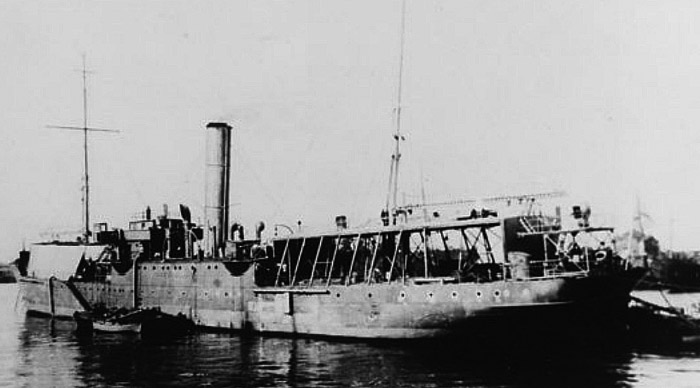
Orlitza, one of several seaplane carriers/tenders used by Imperial Russia in WWI.
Russia’s first and only carrier in the Baltic was the converted 3,800 tons; 12 knots, British built 1903 cargo-passenger, originally named “Imperatritza Alexsandra”. She was converted under the name Orlitza and commissioned by late February 1915, modified to accommodate no less than nine aircraft, four in the afterdeck hangar, five atop deck, but four was more usual. Two could be launched or recovered simultaneously thanks to the cranes port and starboard. She was armed by eight 75-mm guns on high-angle mountings plus two Maxim machine guns. She carried Grigorovich M5 and following flying boats. The was called the “Shipboard Air Detachment of the Baltic Fleet Air Division, Second Brigade”.
Orlitza appears deployed less frequently than its Black Sea counterparts and was mostly an harbour-based seaplane tender, called an “avio-transport” not an “hydro-cruiser” as her sisters.
Her major operation was thee repulse of the German Navy adventure in the Gulf of Riga, summer 1915. Her seaplanes made relentless bombing attacks. The Germans on their side bombaed and torpedoes Slava (first torpedo plane attack on a capital ship) but failed to cripple her.
Orlitza followed later the Baltic Fleet in an attack on the Courland Peninsula, covering an amphibious landing in the Dvina River. In 1916, she was based in the Moonsund archipelago when in July there was a massive German attack. Her seaplanes managed to shoot down two attackers. The next month, she raided the German naval air base on Angern Lake. On Operation Albion (October 1917) on ösel, Moon, and Dago (Gulf of Riga doorway), Orlitza’s seaplanes attacked enemy surface ships and engaged German aircraft, which also had a seaplane carrier, SMS Santa Elena. But most came from land and harbors. This also became the first seaplane carrier vs. seaplane carrier engagement. The Bolshevik revolution brought operations to an end and Orlitza’s air complement were recycled into the odd riverine carrier “Kommuna”, a converted oil barge on the Volga (see later).
 Romanian Carriers (1915)
Romanian Carriers (1915)
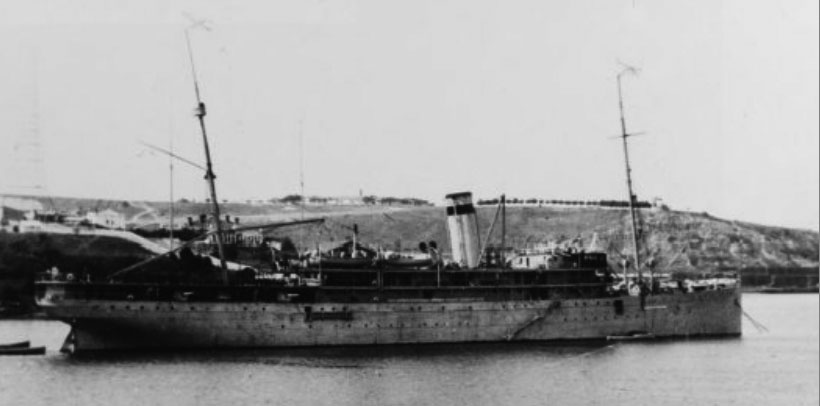
Imp. Pavel I, Regele Carol I. In Russian service there were also the Imperator Nikolai I (photo) and Imperator Alexander I. The Russian Black Sea was reinforced indeed when Romania entered the war against the Central Powers in August 1916 with the five merchantmen from the Romanian State Maritime Service: Principesa Maria, Korol Carl, Ruminia (Romania), and sisters ships Imperator Trayan, and Dakia. The 18-knot Ruminia became a “gidroaviotransport” with three seaplanes (no career records). Principesa Maria was used as a net-layer. The other were rated as “auxiliary cruisers” with a single aircraft each, and they saw limited action in Romanian hands. After the Revolution, they were returned to Romania.
In 1917, all these ships made the Russian Imperial second-largest seaplane carrier force after the Royal Navy
The Romanian vessels were returned after their career as “Black Sea hydro-cruisers”, taken over by the French, then in mercantile service for the Messageries Maritimes as Lamartine and Pierre Loti, until World War II.
 Almaz (1902)
Almaz (1902)
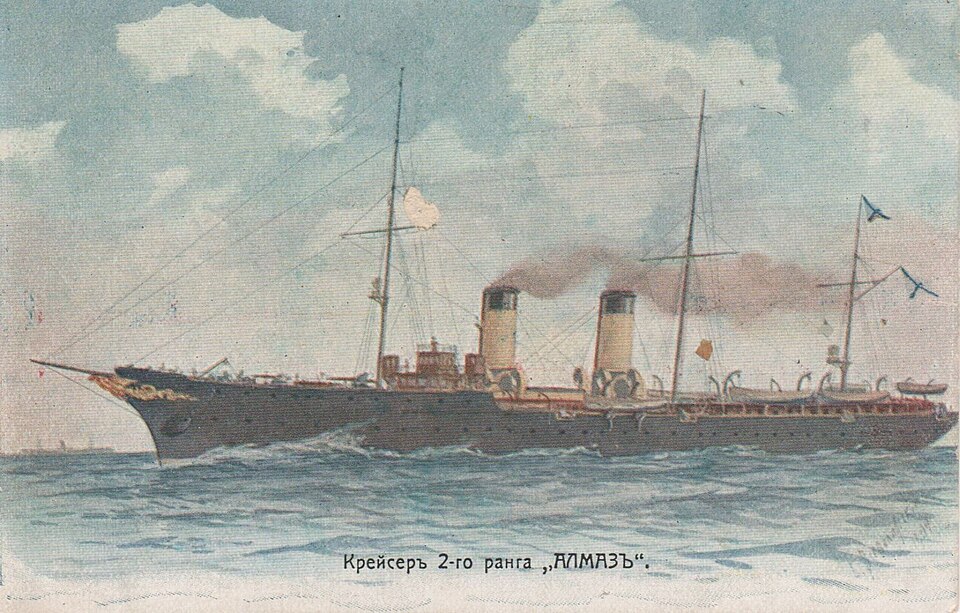
Almaz was built as a 2nd-class masted cruiser in 1902–1903, in Baltic works. Her elegant lines and accommodations made her doubling as Imperial Yacht in peacetime for the Viceroy Yevgeni Alekseyev. In commission from 1903, Алмаз (Diamond) was single in her class. She was reclassified as a Seaplane tender after a conversion in 1915. She was ultimately scrapped in 1934.
This Unprotected cruiser displaced 3,285 long tons (3,338 t)
Dimensons: 365 ft 8 in x 43 ft 6 in x 17 ft 3 in (111.5 x 13.3 x 5.3 m)
Installed power: 2 shafts VTE, 16 Belleville WT boilers: 7,500 ihp (5,600 kW)
Speed: 19 knots (35 km/h; 22 mph)
Complement: 336
Armament (1903): 4 × 75 mm (3 in) guns, 8 × 47 mm (2 in) guns
Armament (1915): 7 × 120 mm (4.7 in) guns, 4 × 76.2 mm (3 in) AA guns, 4 flying boats
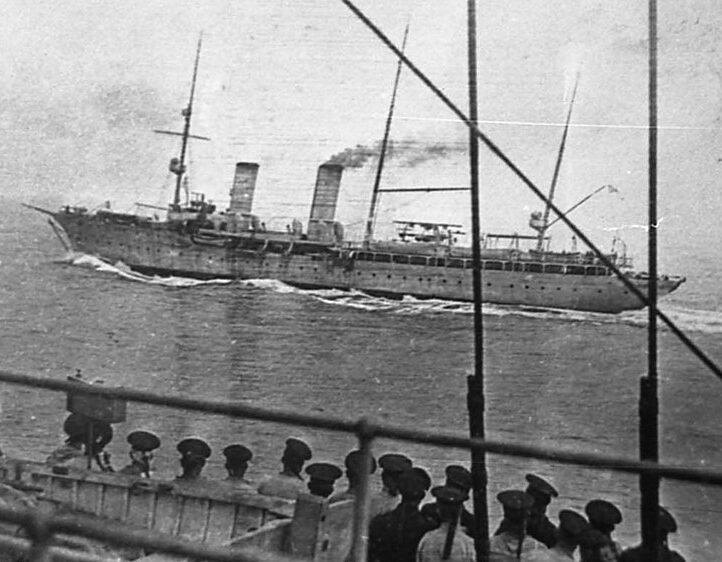
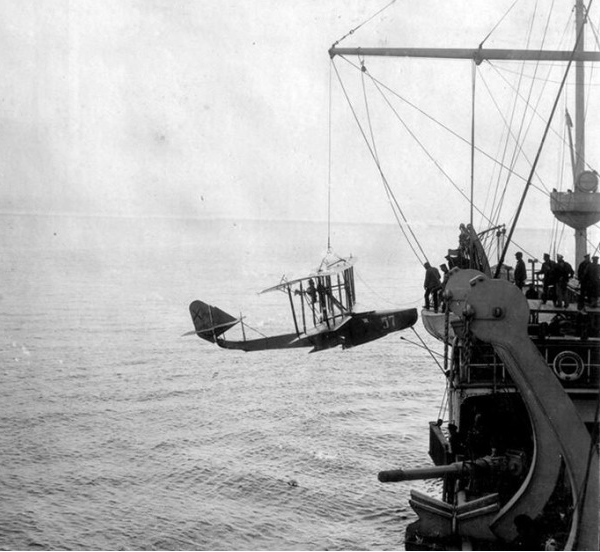
Almaz in 1916, underway (top) and operating a Grigorovith M5 (N°37)
There were also the small torpedo boat Letchik, used as a seaplane tender or as plane guard ship, to rescue downed aviators. After the March 1917 revolution, mass renaming of warships former Imperial Russian hydro-cruisers Imperator Nikolai I and Imperator Alexander I became the Aviator and the Respublikanetz. They took part notably in mine-laying sortie against the Turks by late June 1917.
Civil War Carriers
The Imperial Russian Air Service was disbanded after the Revolution but reorganized. The “Red”, and later Soviet naval aviation units were created in 1918. They took part in the Russian Civil War with ships operated by the Bolsheviks, covering the army from Petrograd, and combating the white Russians in the Baltic and Black Sea. They took a major part in land operations, operating from the Volga, Kama, Northern Dvina and the Lake Onega. A total of 76 old seaplanes supported these forces in a haphazard way. They were also used for ship’s supply and reconnaissance for the army. But one interesting development aside the numerous bases and stations were the first “red aircraft carriers”.
The first were seen on the Caspian Sea, but not on Russian hands. There were two merchant ships taken over by the British intervention in late 1918/early 1919. They were fitted to carry two seaplanes each. They were turned to the White Russians and renamed Volga (formerly Alader Yousanov) and Orlyonok from August 1918. Later they fell into Red hands and postwar return to merchant service.
 Kommuna (1918-22)
Kommuna (1918-22)
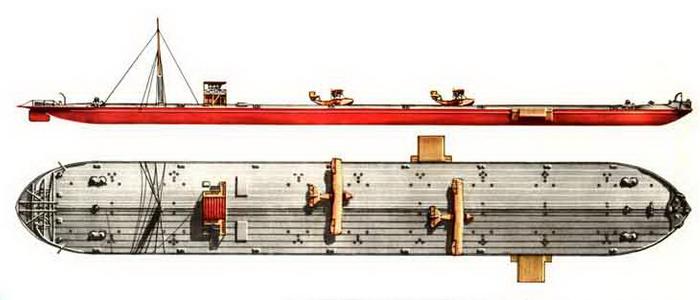
In 1918, the Red Army commissioned an interesting project for the Volga Flotilla, starting from an old oil-carrying barge, namred “Kommuna”. The idea was to convert her into a seaplane carrier. She was equipped with two cranes and a catapult to operate 9 aircraft: Six Grigorovitch M-9s and three French Nieuport 17 seaplanes. The 140 meters [450 feet] vessels by 19 meters was used to provide the army intelligence, and attacking the White Army fortifications and ships. Not self-propelled, she was operated by tugboats along the Volga.

The barge was refurbished and took part in the last operations of the war, also on the Volga, and later converted to a river military transport barge. She was armed with two 37-mm and helped the Bolshevik Volga flotilla, for air cover. A similar converted ship was used by the British on the Tigris River during the Mesopotamian campaign of World War I.
The main issue with these conversions was the absence of a roof (no hangar).
 Death (1919-22)
Death (1919-22)
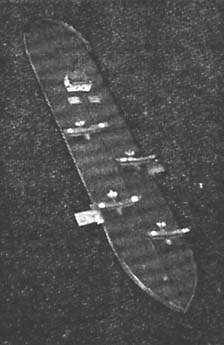 In 1919-1920 a new barge was converted, мертвых or “Death”: Same conversion type as “Kommuna” but 153.7 m by 23.5 m. She was converted at the Sormovo plant. The upper deck was cleared of all superstructures. This time two wooden hangars were built to accommodate up to ten M-9 flying boats. There were floating ramps to be deployed in water on both sides (wooden slopes, on brackets also used to recuperate them without cranes). The planes were simply towed on board and pushed to sea.
In 1919-1920 a new barge was converted, мертвых or “Death”: Same conversion type as “Kommuna” but 153.7 m by 23.5 m. She was converted at the Sormovo plant. The upper deck was cleared of all superstructures. This time two wooden hangars were built to accommodate up to ten M-9 flying boats. There were floating ramps to be deployed in water on both sides (wooden slopes, on brackets also used to recuperate them without cranes). The planes were simply towed on board and pushed to sea.
Interwar Designs
In the early 1920s, the now consolidated Soviet Power made a plan to improve and reorganize the Naval Aviation branch. Soon were ordered new reconnaissance seaplanes, bombers, fighters with land bases and harbour-based units dependent on regional fleet commands. By 1935 this became a powerful Naval Air Force in support of the Baltic and Black Sea Fleets, and at last, for the Pacific Fleet: 1,445 aircraft. This chapter is further covered in the generic WW2 Soviet naval aviation page (see below) with a study of the Aviatsiya Voenno-morskovo Flota in WW2 (the great patriotic war).
All this time, the Soviet naval command was perfectly aware of the role and numbers of aircraft and seaplane carriers built by western naval powers, as well as, more worryingly, by Japan. There were constant projects to have at least one carrier to accompany the fleet. However, budgets were restrained and plans favoured other types, liked submarines, as carriers were seen as tools for a projection of power whereas Stalin’s new of the Navy was essentially defensive at this point. Only when the Soviet industry had reach full capacity and the capabilities of the army and air force had been considerably improved, Stalin from 1936-37, returned to see the concept of projecting naval power more favourably, notably as way of international influence, notably to potentially friendly nations abroad.
Unfortunately, “classic” projects such as building new capital ships had all priority until the invasion of 1941 and none of the projects seen below saw the light of day. Impressive they may be, but they remained paper projects only. More so, it took almost 20 more years postwar for the USSR to seriously consider such types again, by building a pair of helicopter cruisers, the Moskva class. A timid first step followed by the Kievs and ultimately new “true” carrier projects.
 Izmail (1925)
Izmail (1925)
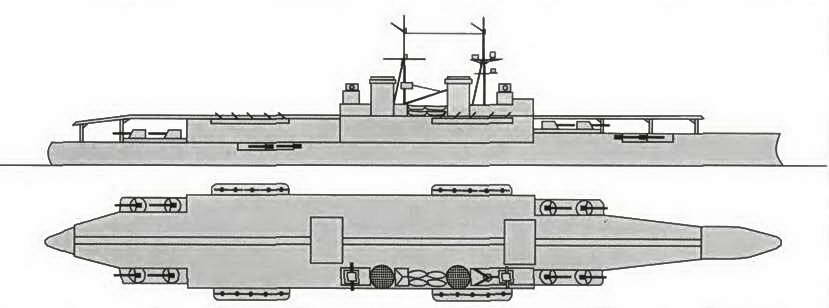
In 1922 the new directorate had on its hands one of several very large battlecruisers known as the Borodino class. Started in 1913, launched in 1915, these ships were in various states of completion when the Revolution started in 1917, they were advanced enough for possible conversions. They had indeed massive hulls, 220 m long, but a narrow beam, but they were fast (26 knots as planned, probably more if the armour was thinned down and provided with a more modern powerplant). The British started these battlecruisers conversions, followed by the US and Japan. So it was not stranger to the Soviet naval staff at the time
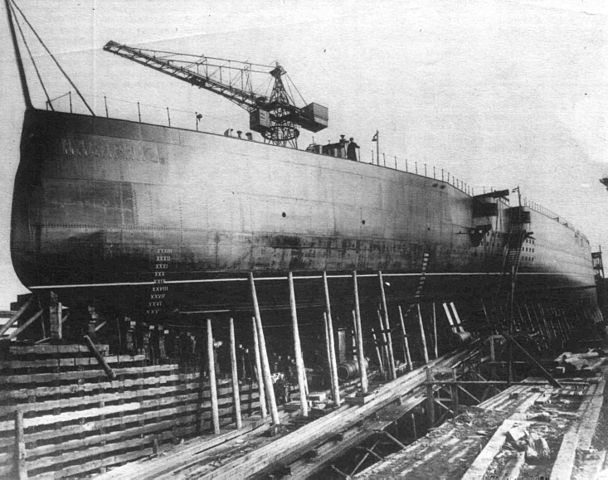
The incomplete Navarin in 1916 in St Petersburg. She was later scrapped as her sisters in Germany.
In May 1925, Izmail was still available, her hull in laying in the Baltic Yard of Petrograd. The Administration of the Soviet Navy discussed another option, more in line with international naval developments, than completing a 1911 battlecruiser design. Izmail was proposed to be converted as an aircraft carrier. Indeed, there was no shortage of examples of such conversions, framed by the treaty of Washington: The US Lexington class and the Japanese Kaga and Akagi were at that time in full reconversion. The experience of the Royal Navy showed this was not only possible, but potentially can bring new capabilities to the Navy. Some schematics were drawn around the hull, which was 230 m long, more than enough to carry a roomy landing deck.
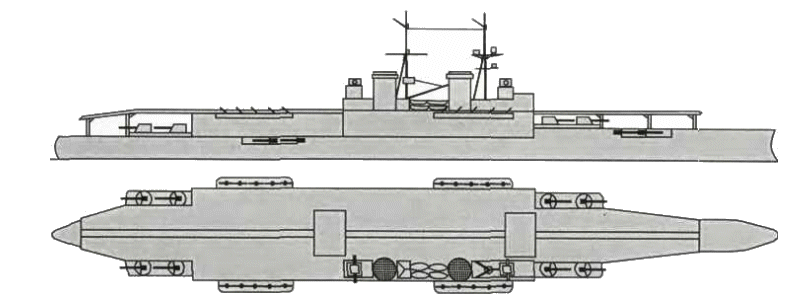
Izmail, alternative proposed Aircraft carrier (“aviamatka”)
As defined, specifications of the new carrier were a top speed of 27 knots (50 km/h; 31 mph), while the hangar carried up to 50 aircraft. The armament was also brand new, integrating eight 183-mm (7.2 in) guns in casemates, the new calibre designed for the Kirov class cruisers but also eight 102 mm guns in turrets. Armour protection was of course much reduced, down to 76 millimetres (3.0 in) for the belt. As shown by the reconstructed scheme, this was a kind of “hybrid” design typical of the time. There was little confidence to the aviation on board to defend the ship, so she was armed with the firepower equivalent of a cruiser, basically her potential escort. The guns were mounted in sponsons, in single turrets fore and aft, in tandem. In addition, eight 183 mm (7.2 in) casemate guns were kept, left in their original positions fore and aft, the forward pair being raised in the forecastle.
The flying deck was much shorted than the bow and also the stern, and narrow as the beam, but on either side for the sponson guns. The close hangar was also short, starting at the level of the island, about 1/3 from the prow. It was also stopped about 1/5 short of the stern. This would have made the accommodation of 50 planes unlikely, but only if using folding wings. The island itself was rather low, and long, and not built off-set to port but on the deck. There were two telemeters for the main artillery fore and aft of it and two tripod masts with projectors. The hangar was served by two lifts along this island. AA artillery was quite impressive for the time, presumably made of 37 mm guns, twenty in all, in four offset platforms fore and aft of the hull at flying deck level.
The “Tactical RKKF aircraft carrier had its speed set well above battleships, “to meet their special tasks the aircraft carrier will separate from the battleships and her condition is joining them in the shortest possible time“. The final air group, which looked more realistic, consisted of:
-12 torpedo bombers
-12 fighters
-6 Scouts and 5 artillery spotting planes (“special-purpose aircraft”).
No studies for modifying aircraft for carrier service were done, as the whole project was to be first validated.
The alternative protection included still 237 mm armor plates for the main belt, or leaving it to 76 mm, while the main flight deck was armoured, at 51-64 mm armour as designed. This could have been the first carrier with an armoured flight deck, such as the British built at the end of the 1930s and the US in 1943.
Final design approximative displacement was around 20,000-22,000 tons, for a top speed of 27 knots. The schematic design of the NTK UMVS was approved on July 6, 1925.
This proposal was eventually approved by Alexey Rykov, Chairman of the Council of the People’s Commissars, on 6 July 1925. However, the Red Armyat the time considered it was a costly naval project, not in line with the supposed defensive stance of the Navy at that time. The Red Army staff therefore strongly opposed and it, managing to block the project by gaining control of the commission reviewing the needs of the Navy in December 1925. The conversion project was cancelled on 16 March 1926 and the incomplete Izmail was scrapped from 1931 in Leningrad. This was not the last aircraft carrier project of the USSR, but certainly it was the first. The Russian navy however had some experience operating seaplane carriers during WWI.
 Komsomolec (1923)
Komsomolec (1923)
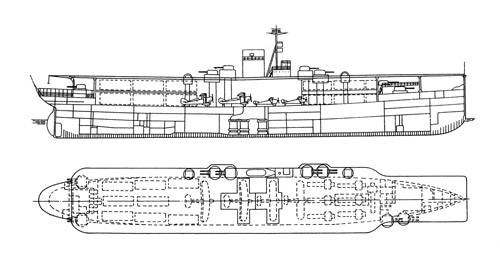
The training ship Okean was a former passenger liner from German Howaldtswerke shipyard. She was used to training naval machinists and fire feeders, and in the Russo-Japanese war escorted ships of the 2nd Pacific Squadron to the Mediterranean Sea as a supply vessel. She was renamed Komsomolets in 1922. In 1927, she was supposed to be rebuilt as a training aircraft carrier, but her fitting out, as proposed, was never realized.
If converted, she would have been able to deploy 26 undercarriage type fighters and 16 ground attack aeroplanes, and was armed herself with sixteen 102 mm guns and ten 40 mm AA guns. She had doubled hangars and a pair of cross-shaped lifts amidship. The idea was to prepare these in this space, unfolding wings, installing bombs and ammunitions, fuelling them, before lifting them up and launching them. The bombers were located aft, fighter forward in their own separate areas. The design had merits, but it was obviously not very large, and it’s dubious if it had been capable of proper simultaneous operations with planes landing and other being launched, from the amidship deck, without catapults. They were also well armed, as typical of the 1920s when it was believed these ships needed to be protected against bad encounters when operating independently.
History:
The ‘Komsomolets’ conversion was to be performed from 1927, based on a former training ship, but the conversion was never done. If so, it was probably for 1932-33. However, at 15 kts, unable to fleet operations, making the Borodino class more appealing.
Displacement: 12.000 ton standard, Length 143.2 meter, Top speed 15 knots, Capacity 42 aircraft. Armament as above.
Plans to convert her were set up in the first 5-year plan but were rejected when Red Army politics resulted in Navy budgets cuts and purges which gutted the Navy of any personnel advocating for the construction of large warships. The Soviet leadership rejected more ambitious conversions in March 1926 since the army by July would direct the navy’s budget. In 1927, the Scientific Technical Committee still presented the Komsomolets sketch as “a first approach to the questions of outfitting an aircraft carrier”, an innocuous study.
As the training ship Okean her powerplant comprised several types of boilers to familiarize the recruit and had been outfitted with a new and homogeneous boiler set-up. In 1929 a clash of Soviet and Chinese armed forces over the Chinese Eastern Railway saw a change of attitude as the Red Army could not be supported by naval forces in the region.
It was also learned about the Turkish modernization of the battlecruiser Yavuz, and its purchase of Italian submarines. Attitude changed completely towards ‘heavy’ ships and called for a strong reinforcement of the Soviet Pacific Fleet, but the new purges put an end to this endeavour.
Komsomolets, if built, would have been a Soviet “Hermes”. But all came from this proposal was to create a prototype deck for aircraft, the “SHON”. The lack of funds sealed the fate of this project. For ten years, carriers disappeared from shipbuilding priorities under the “Small Fleet” doctrine.
 Project 71 (1939)
Project 71 (1939)
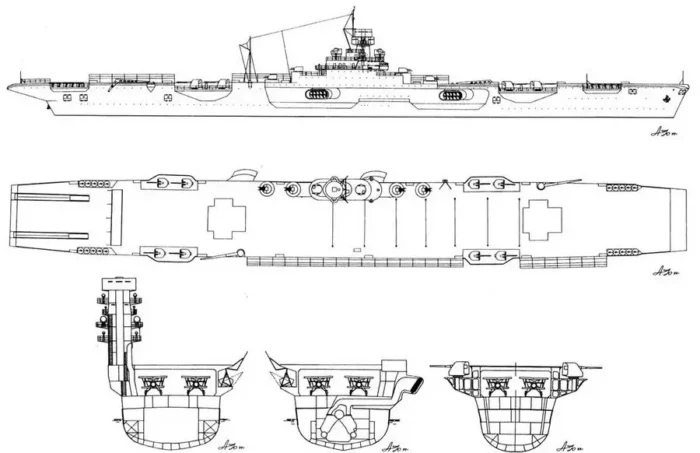

After a long eclipse, the naval command reconsidered the concept of aircraft carrier, this time no longer a conversion but a new built, looking at foreign dedicated construction such as the 1936 British Ark Royal, US Ranger, Japanese Hiryu/Soryu. Not only this time funds could be easier to be allocated as the context was more favourable, and they stuck better with the new 1938 naval plan which included not four battleships and four battlecruisers, but no less than sixteen Project 23-class battleships.
This third 5-year plan of 1938 was by far the most ambitious, under the personal guidance of Stalin, more anxious than ever to give the USSR a maritime strategy from defensive to resolutely offensive. He advocated a strategy within the Admiralty which was soon gutted, since purges had gone by and the men in charge, were not the most competent.
This plan foresaw fast battleships and battlecruisers, resulting of the London naval conference in 1936 ending the Washington moratory. Some, before the purges, wanted at least four modern fleet carriers, but they were not heard. Staling wanted 19 battleships and battlecruisers, 20 cruisers, 18 squadron destroyers, 145 destroyers, 341 submersibles, 514 MTBs, and 44 river monitors. No carrier was planned. These figures were subsequently reduced for the lack of funds, classes were standardized to simplify production. The plan was never carried out. The Sovietsky Soyuz class battleships, Kronstadt class battlecruisers and Chapayev class cruisers laid incomplete after the invasion of the summer 1941. Only the latter were completed postwar.
This aircraft carrier was to be a class lead ship, included in the Soviet shipbuilding program of 1938. Foreign designers collaborated to create this traditional and tailored aircraft carrier design, published as Project 71 in mid-1939 when completed. This was a Ranger-like carrier rather small with a displacement of 11,300 tons, but well armed, with eight 100-mm universal DP guns sixteen 37 mm AA guns and twenty 12.7 mm or 0.5 inches machine guns. Her capacity was only 20 aircraft, served by 2 catapults forward. There was a deflector behind the catapults, also acting as an arresting barrier in case the landing planes overshoot. There were two cross shaped lifts located after and further forward close to the island.
Like Japanese designs, and to avoid a massive island, the exhausts were truncated on the starboard side below the island. The latter was rather developed, and included a central CT and mast use for fire control with various telemeters and FCS posts. Albeit it could be compared to USS Ranger by its limited tonnage, the aircraft capacity was much reduced. USS Ranger indeed tested the maximal capacity possible for its tonnage (14,500t standard) and reached 86 (maximum) and 76 (normal). But Rather lacked the armament of Project 71 and was virtually unprotected. Project 71 looked more towards the British Colossus class. They were relatively similar in size, albeit the tonnage figure given for the Soviet design looks underestimated When fully loaded it would have been around 15,000 tonnes at least.
The carrier appeared in “Jane’s Fighting Ships” 1938-1939 listed as the “Red Banner” along with another ship of this type, supposed to be laid in Leningrad in 1939-1940. Characteristics are similar to Project 71 with a displacement of 12,000 tons, speed 30 knots, armament twelve 100 mm DP, 40 aircraft. In Soviet publications according to the 1937 treaty, USSR was obliged to provide information to the British about its characteristics, albeit USSR was still not officially bound by the Washington on London treaties. Nikolai Kuznetsov was appointed in April 1939 as the People’s Commissar of the Navy and solidified the 3rd 5-Year Plan of 1938-1942. Thanks to his revision, not one, but two carriers of that class were to be laid down, one for the Northern and Pacific fleets. By January 1940 the ambitious plan was reduced by half, and Stalin decided against the aircraft carriers, preferring instead to concentre on the battleships.
Kuznetsov however never abandoned the idea and gave instruction to TsKB-17 (V.V. Ashik) to continued their development, and work was carried out on a new large aircraft carrier with a two-tier hangar for 62 aircraft, which became project 72 (little info available) and a small one hangar level 32 aircraft project 71. The fighters planned were the modified Yakovlev Yak-9K fighter, and the torpedo bombers developed by the Tupolev design bureau as the PT-M71. It was planned to launch aircraft in a free take-off from the flight deck for quick launch, as in US practice, and the use of catapults was only at maximum take-off weight in adverse weather conditions.
By February 1938, the Navy’s Main Staff approved requirements for an aircraft carrier still to roam an enemy coast with reconnaissance and attack. This new sub-project was an evolution of the Project 71 housing 45 fighters and light bombers, and armed with eight 130-mm guns, eight twin 37 mm anti-aircraft guns. CRI-45 prepared this as project 71a. There were no specific requirements attached to this design, but the TTZ prevised it would be still averaging 13,000 tons in standard displacement. The armament was revised to six or 3 twin 130mm gun mounts, eight twin 100mm guns and four quadruple 37mm AA guns. In the final version, the armament was down to 8 single 100mm, four quadruple 37 mm. Heavy AA armament that early in the war was forward-thinking for the Soviet authorities. Their initial speculations about AA defence without thinking around a “task force” precluded 1944-45 Essex class armament.
Project Chkalov was the conversion of the fourth Chapayev class cruiser as a variant of the Project 71, called Project 71B.
The hull and power plant of the Type 71 were from Project 68 Chapayev class light cruisers, under construction. Project 71 was ultimately approved in 1941 with the first planned to be laid down in 1942. Of course, Barbarossa stopped this planning and construction was cancelled. Six were planned in 1941, which would have given USSR overnight a strong, homogenous carrier force, if realized to the full in 1943-44. Designers continued working, though, on the upgraded Project 72 in 1944 (see below).
⚙ specifications |
|
| Displacement | Standard 10,600t, 13,150 t FL |
| Dimensions | 195m (via waterline) x 24m x 5.88m |
| Propulsion | 4x steam turbines, 4 steam boilers c110,000 hp |
| Speed | Top speed 34-35 knots |
| Range | 2,550 tons of oil, c8000 nm |
| Armament | 8x 100mm DP, 4×4 37mm, 20x 12.7mm HMGs AA. |
| Protection | Belt 100-75mm, Main deck 90mm, Command center 50mm |
| Sensors | Unknown |
| Air Group | 10 recon-bomber, 20 fighters |
| Crew | c2000 |
*5km range, 160-180 rpm
 Project Kostromitinov (1939)
Project Kostromitinov (1939)
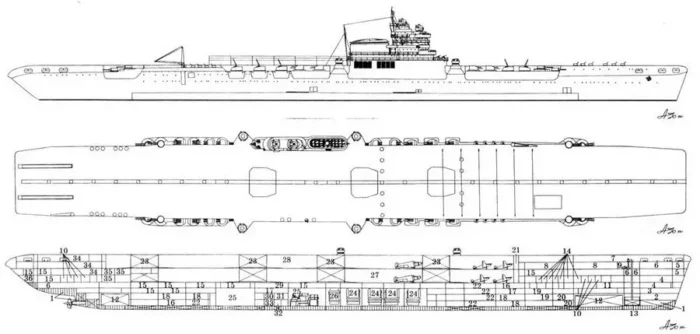
Project Kostromitinov is one of the most interesting, yet least known, of all the carrier projects. It’s a study of Lieutenant Kostromitinov, who studied the concept of KMS Graf Zeppelin. The design looked alike to the latter, but much larger at 300m overall in length for a displacement of over 50,000 tons full, so comparable to the Midway class.
On paper with its two superposed hangars like Ark Royal it could carry 66 Fighters and 40 torpedo bombers, 106 in all, so comparable to the Yorktown and Essex classes. But the overall style recalled the Illustrious class (which had a single hangar, unlike the later Indefatigable class). Armouring two hangars was a stability issue, and the limited height of said hangars were an issue for late aircraft upgrade, as shown by the Indefatigable. This carrier had a massive island integrating the funnel, with a tower for fire control integration, but the overall profile remained low. This was a massive design, still, with eight deck total for the hull alone.
As customary for Soviet carriers it was well defended with a large armament, a bit old school though, of eight twin 6-in (152 mm) guns in low sponsoned super firing turrets fore and aft. This very looked like British armoured carriers of the Illustrious class, again a clear influence. They also had four triple and six twin 100mm AA guns, and eight quadruple 37mm, twenty-two twin 23 mm AA guns. A most formidable defence, as again, it was supposed to operate with a light escort, nothing like a task force. This unnamed Project showed two catapults forward and a full enclosed bow lip, plus three axial lifts (with fuller shapes) and a smaller starboard lift for a wing folded aircraft only. The very long deck was thus usable for a “sunday punch” style massed launch or a “noria” style launch from the three lifts. Details about the powerplant are unknown.
It was also relatively well armoured, with a hangar floor deck protected by 130 mm (5 inches) to keep stability and protect all vitals, as the ammunitions magazine and power plant. It was reduced to 50 mm (2 inches) on the main flight deck above, participating in the strength deck as well. The belt was 100 mm thick (4 inches) and the hangar was protected on all sides by 40 mm (2 inches) walls. Propulsion was probably made of four steam turbines installed on the new Chapayev class cruisers for a top Speed of 32 knots and a range of 8000 nm at 18 kts.
⚙ specifications |
|
| Displacement | 50,000 tons |
| Dimensions | 300m (990 ft) long. |
| Propulsion | Unknown, probably 6-8 Chapayev class turbines or Kronstadt class turbines |
| Speed | 32 knots, 18 kts cruise |
| Range | 8000 nm at 18 knots (14,800 km) |
| Armament | 8×2 152 mm, 4×3 & 6×2 100mm, 8×4 37mm, 22×2 23 mm AA |
| Protection | Deck: 50mm top, 130 mm floor, belt 100mm, hangar 40 mm |
| Air Group | 106: 66 fighters, 44 TBs |
| Crew | c2000 |
 Project 72 (1944)
Project 72 (1944)

Project 72 was studied in 1944-45 and in most sources it is mentioned at least two variants of this project, one showed here with displacement and size of roughly the same as UK Illustrious class and another one considerably larger with approx. 62 aircraft and displacement of over 30 000 tons.
CDB-17, formerly Neva PKB, was formed on 18 January 1931, became TSPKB-1 in 1932, CDB-17 in 1937. In 1943, it was authorized to push ahead with design work on Project 72 under V.V Ashik, former chief designer on battleship projects. Progress was slow with priorities reallocated, in the final push against Germany. There was a serious doubt about Soviet requirements for such ships in 1945.
In 1945, a ten-year naval modernisation for the Navy was approved by Stalin, including battleships and heavy cruisers but not mentioning aircraft carriers, to the irritation of Kuznetsov, which can only narrate his frustation to this closer friends to avoid the Gulag. Design work focused now on the Project 30Bis Destroyers by CDB-17 as well as the Project 68K Light Cruisers (Chapayev Class) and 68Bis (Sverdlov Class). No official documentary evidence of the conversion of a Kronstadt Battlecruiser emerged also in 1945. Graf Zeppelin still, was allocated as war reparation to USSR. Thus is conflicting information about her fate nor any plans to repair and complete her for service, but it was certainly inspected by teams of engineers and designers. The carrier remained at Swinemünde until August 1947, sank under tow to a Soviet port or deliberately scuttled or tested sunk by ordnance, with her wreck rediscovered in 2006.
⚙ specifications |
|
| Displacement | c30,000t |
| Dimensions | 190m (623 ft) |
| Propulsion | 4x steam turbines, 4 steam boilers 144,000 HP |
| Speed | Top speed 30+ knots |
| Range | c7000 nm |
| Armament | 6 or 8×2 AA 130mm, 4×2, 8×1 single AA 85mm, 12×2 AA 37mm, 24×2 AA 23mm |
| Protection | Belt 90mm, Deck 30mm + 50-80mm |
| Air Group | 62, c30 recon-bomber, 32 fighters |
| Crew | c1800 |
 Project 69AV (1945)
Project 69AV (1945)

This large aircraft carrier project, but based on the hull of a Kronshtadt-class cruiser to gain time. This Kronshtadt class conversion proposal was Project 69AV. Project 69AV allegedly dated 1945-46 when allegedly studied as a conversion of the incomplete heavy cruiser project 69 Kronstadt. It was a premilinary study of feasibility, to see if it could be modified as a aircraft carrier. As converted, its estimated capacity was to be 76 aircraft and the armament allegedly eight 8 twin DP 130mm guns and 16 twin 37mm AA guns. Again, there are no official documentation confirming this.
There was also a supposed conversion of Project 23 (Sovietsky Soyuz) but it went nowhere. This would have been an heavy-armoured heavy aircraft carrier comparable to IJN Shinano. Again, it’s likely made up by Wargaming for one extra entry in the world of warship fictional carrier tree.
Cold War Projects
 Project 85 (1954)
Project 85 (1954)
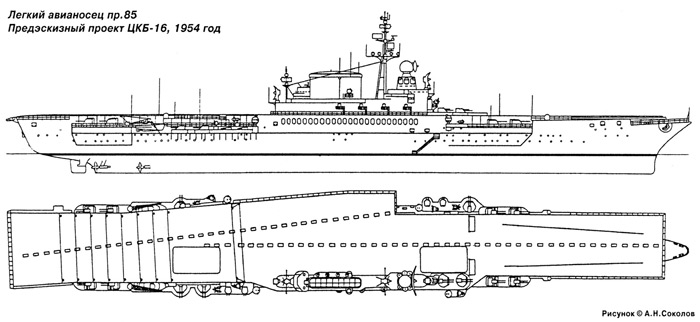
Albeit a Cold War project, it was added it there as a 1950s design, transitional before what led ultimately to CATOBAR projects such as the Orlan in the late 1970s and ultimate Kuznetsov class which details previous projects. This Soviet CVL dated 1954 really recalls French projects such as the French Clemenceau Class in general outlook and size.
It was characterized by a weaker protection and more specialized AA armament.
⚙ specifications |
|
| Displacement | c35,000t |
| Dimensions | c260m long (850 ft) |
| Propulsion | Unknown |
| Speed | c30 kts |
| Range | c8000 nm |
| Armament | 8×2 100mm, 6×4 57mm, 8×4 25mm AA |
| Protection | Belt 90mm, Deck 20mm + 70mm |
| Air Group | 40 “Tigr” (Mig-19 variant) fighters, 2 Mi-1 helicopters. |
| Crew | c2200 |
Air Groups
Various models had been floated around for the previous carrier designs, notably the Polikarpov I-15 and Polikarpov R-5T biplanes, albeit little information is available on the latter.
The I-15 was an all-metal biplane, predecessor of the I-16. However there is little information of a possible carrier-capable version. Compact, it would have kept fixed wings.
The I-15 was a sturdy little brute capable also of dive-bombing, carrying two small bombs under racks underwings.
The R-5 was a sturdy, large reconnaissance model that was large and powerful enough to be declined into a torpedo carrier with a standard 45 cm model.
Other ideas floated out for the Project 68, 71 and 72 were the Grokhovsky G-37 torpedo plane, Polikarpov I-180 fighters, and Kochyerigin BSh-1 skip bomber. All three remained at prototype stage in the real world. Other models for latter projects were revoked such as the Yakovlev Yak-9U, Tairov Ta-3 and Sukhoi Su-2, Lavochkin La-5FN, Lavochkin La-9, Chyetverikov PT-1 (M-82), Tupolev PT-M71 Torpedo Bomber and Polikarpov VIT-2.
Polikarpov R-5T:
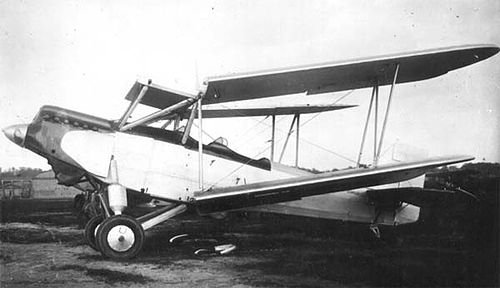
Note the folded wings.
Grokhovsky G-37 “ULK”:
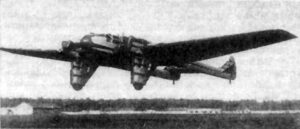 A real world model, this utility aeroplane was produced in 1933 by Zavod 47 in Leningrad (first flew in May 1934). Empty Weight 8818 lb, TO 12125 lb, Max TO 13779 lb. wp 73 ft 9 in, fuselage 49 ft 10 in, height 15 ft 5 in WA 904.17 ft2.
A real world model, this utility aeroplane was produced in 1933 by Zavod 47 in Leningrad (first flew in May 1934). Empty Weight 8818 lb, TO 12125 lb, Max TO 13779 lb. wp 73 ft 9 in, fuselage 49 ft 10 in, height 15 ft 5 in WA 904.17 ft2.
2x Mikulin M-17 493 hp engine (177 mph in 8202 ft), Climb Rate 1099 ft/min, 3 min to 3281 ft. Ceiling 26,411 ft. 650L fuel, range U. Unarmed prototype but twin DA LMGs in navigator´s cabin and 1 tons of bombs or single 450mm torpedo.
Polikarpov I-180:
Prototype replacement for the I-16 with a more powerful engine, promising in 1938, but production was denied after Yakovlev heavy lobbying. Never officially intended as a naval fighter.
Kochyerigin BSh-1:
Ground attack aircraft with a Tumansky M88 or M87A radial, only 2 prototypes in 1939.
Yakovlev Yak-9K fighter
45 mm NS-45 cannon with 29 rounds and characteristic muzzle brake.
Chyetverikov PT-1 Torpedo Bomber
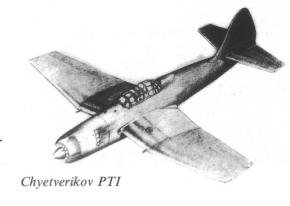 Paper project, 1940 carrier-based design. Chyetverikov PT-1 torpedo-fighter from 1945-47, intended for the Project 72 or Kostromitinov. From Guston’s Osprey Encyclopedia of Russian Aircraft.
Paper project, 1940 carrier-based design. Chyetverikov PT-1 torpedo-fighter from 1945-47, intended for the Project 72 or Kostromitinov. From Guston’s Osprey Encyclopedia of Russian Aircraft.
The PT-82 from I.V.Chetverikov (OKB-№256, Plant No. 458) had a wingspan of 18.5 m, length of 14.9 m with two ASH-82 engines, crew 2-3, designed in 1944-45 as a preliminary project under the TsNII-45 for the carrier project 72.
MIG-19 Tigr
It was a planned navalized Mig-19 paper project, to serve alongside the Tu-91 torpedo bomber and navalized Mi-1 “Hare” for the Project 85. Supposed close to the MiG-19PFK “Farmer-D” and 19PM “Farmer-E”. It seems tests were performed on a land deck for launches and arrested landings still.
Read More
Books
Stalin’s Ocean Going Fleets, Maslov: Marine Planes of the USSR
“Arms and equipment”; N. Valuev, S. Skrynnikov” Naval aviation “(Inkombook 1995)
Maslov M.A. Soviet ship-based reconnaissance aircraft. Carrier-based aircraft for Stalin’s Great Fleet. M. Yauza; EKSMO. 2013
Failed “Aircraft Carrier” Powers, Analytical Supplement to the Reference Book “Warships of the World” A.V. Platonov. I.Yu. Alekseeva publisher
Artistic Design and Graphics by Yu.V. Apalkov.
Links
coollib.net/
warhistory.org imperial ussian navy seaplane carriers
usni.org magazines proceedings 1971 early russian shipboard aviation
On secretprojects.co.uk/
web.archive.org list-of-soviet-cvs-projects
globalsecurity.org/ Project 71
globalsecurity.org Project 72
alternathistory.org.ua palubnyi torpedonosets pt-1 m82 okb chetverikov projekt 1944
war-russia.info nomenklatura vooruzhenij tyazhelyj shturmovik tsh-1 1931
ecretprojects.co.uk threads russian carrier aircraft designs 1940s
en.topwar.ru russian aviation projects
wunderwaffe.narod.ru/

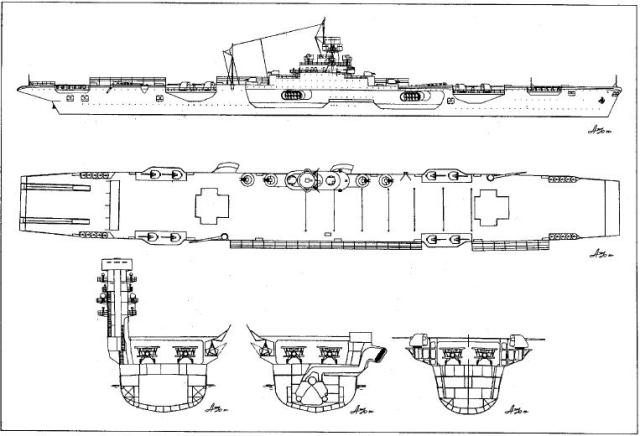
 Latest Facebook Entry -
Latest Facebook Entry -  X(Tweeter) Naval Encyclopedia's deck archive
X(Tweeter) Naval Encyclopedia's deck archive Instagram (@navalencyc)
Instagram (@navalencyc)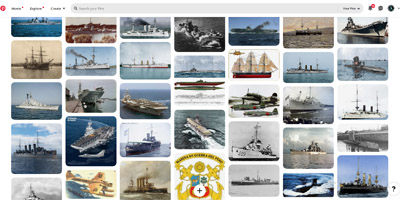


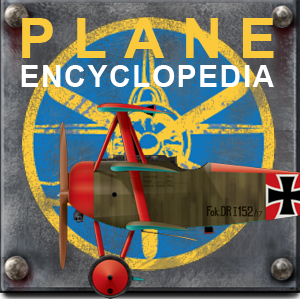
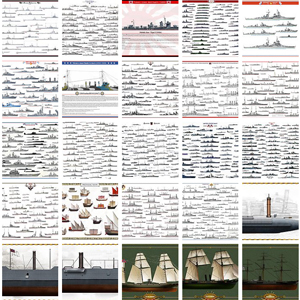
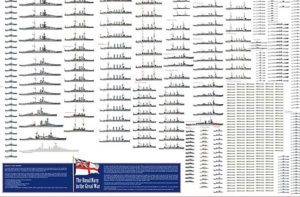
 French Navy
French Navy Royal Navy
Royal Navy Russian Navy
Russian Navy Armada Espanola
Armada Espanola Austrian Navy
Austrian Navy K.u.K. Kriegsmarine
K.u.K. Kriegsmarine Dansk Marine
Dansk Marine Nautiko Hellenon
Nautiko Hellenon Koninklije Marine 1870
Koninklije Marine 1870 Marinha do Brasil
Marinha do Brasil Osmanlı Donanması
Osmanlı Donanması Marina Do Peru
Marina Do Peru Marinha do Portugal
Marinha do Portugal Regia Marina 1870
Regia Marina 1870 Nihhon Kaigun 1870
Nihhon Kaigun 1870 Preußische Marine 1870
Preußische Marine 1870 Russkiy Flot 1870
Russkiy Flot 1870 Svenska marinen
Svenska marinen Søværnet
Søværnet Union Navy
Union Navy Confederate Navy
Confederate Navy Armada de Argentina
Armada de Argentina Imperial Chinese Navy
Imperial Chinese Navy Marinha do Portugal
Marinha do Portugal Mexico
Mexico Kaiserliche Marine
Kaiserliche Marine 1898 US Navy
1898 US Navy Sovietskiy Flot
Sovietskiy Flot Royal Canadian Navy
Royal Canadian Navy Royal Australian Navy
Royal Australian Navy RNZN Fleet
RNZN Fleet Chinese Navy 1937
Chinese Navy 1937 Kriegsmarine
Kriegsmarine Chilean Navy
Chilean Navy Danish Navy
Danish Navy Finnish Navy
Finnish Navy Hellenic Navy
Hellenic Navy Polish Navy
Polish Navy Romanian Navy
Romanian Navy Turkish Navy
Turkish Navy Royal Yugoslav Navy
Royal Yugoslav Navy Royal Thai Navy
Royal Thai Navy Minor Navies
Minor Navies Albania
Albania Austria
Austria Belgium
Belgium Columbia
Columbia Costa Rica
Costa Rica Cuba
Cuba Czechoslovakia
Czechoslovakia Dominican Republic
Dominican Republic Haiti
Haiti Hungary
Hungary Honduras
Honduras Estonia
Estonia Iceland
Iceland Eire
Eire Equador
Equador Iran
Iran Iraq
Iraq Latvia
Latvia Liberia
Liberia Lithuania
Lithuania Mandchukuo
Mandchukuo Morocco
Morocco Nicaragua
Nicaragua Persia
Persia San Salvador
San Salvador Sarawak
Sarawak Uruguay
Uruguay Venezuela
Venezuela Zanzibar
Zanzibar Warsaw Pact Navies
Warsaw Pact Navies Bulgaria
Bulgaria Hungary
Hungary

 Bundesmarine
Bundesmarine Dutch Navy
Dutch Navy Hellenic Navy
Hellenic Navy Marina Militare
Marina Militare Yugoslav Navy
Yugoslav Navy Chinese Navy
Chinese Navy Indian Navy
Indian Navy Indonesian Navy
Indonesian Navy JMSDF
JMSDF North Korean Navy
North Korean Navy Pakistani Navy
Pakistani Navy Philippines Navy
Philippines Navy ROKN
ROKN Rep. of Singapore Navy
Rep. of Singapore Navy Taiwanese Navy
Taiwanese Navy IDF Navy
IDF Navy Saudi Navy
Saudi Navy Royal New Zealand Navy
Royal New Zealand Navy Egyptian Navy
Egyptian Navy South African Navy
South African Navy






























 Ukrainian Navy
Ukrainian Navy dbodesign
dbodesign